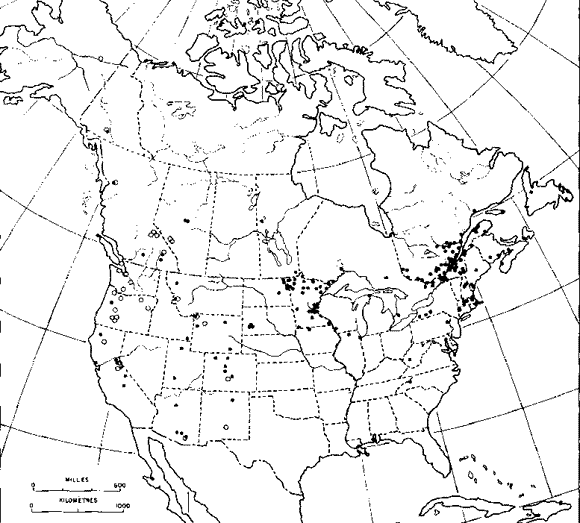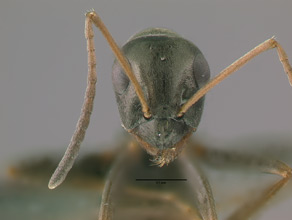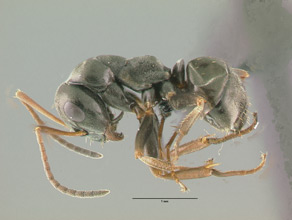- Identification
- Medium-sized black workers that belong to the fusca species group within the fusca species complex. This group can be distinguished from other Formica species by their coloration (mainly black or brown body or with a dark colored head and gaster with a darker yellowish mesosoma). It can be difficult to key out many fusca species without prior experience, a good reference collection and samples that are part of a nest series. Some rarely used morphological characters (features of the metothorax) are useful for separating the forms into species complexes. A key to the workers is provided in Francoeur (1973).
- In general most Formica fusca workers from the Navajo Reservation will bear the closest resemblance to subsericea species group (Formica argentea and podzolica occur on the Reservation). Differences between Formica fusca and subsericea forms include a less pilose metasternum, moderate pubescence on the gaster and an absence or low number of hairs on the top side of the first gastric segment (excluding a row of hairs along the distal fringe).
- Biology
- This species prefers woodland and forest habitats but will may also be found in mid-succession stage old fields. Dead wood is a preferred nesting substrate but Formica fusca will also nest in the soil, in debris and under rocks.
- additional biology notes...
- Distribution
- Range
- Canada, United States and Europe. Based on Francoeur (1973):
From the specimens examined, this species is found in all Canadian provinces except Prince Edward Island and Saskatchewan (which is likely a lack of sampling). It occurs in the United States in at least 23 state. The species descends southward along the Appalachians in the east and west to New Mexico and Arizona near the Mexican border. It is also found in the western U.S. mountain regions.
- The map below is from Francoeur (1973) and shows sampled occurrences of two forms (the open and closed circles) that are currently designated as Formica fusca.
- Navajo Reservation Records
- Samples being processed.

- Additional Notes
- Species from the Formica fusca group are some of the most heavily parasitized ants in North America. Other Formica and Polyergus species exploit fusca group species by enslaving their workers or through new queens of these other species parasitizing existing fusca species colonies. The former occurs as the result of brood raids where the exploitive species infiltrates a nest and carries off both larvae and pupae. The latter occurs through a newly-mated foreign queen entering a fusca species nest, killing the queen and tricking the workers of the dequeened nest into raising her brood. Through time the fusca workforce is replaced by workers off the new species.
- The large number of references to the North American form of Formica fusca in the literature are mostly suspect in their identification (see Francoeur 1973). It therefore follows that we are not as well informed about the biology of this species as one might believe from a search of Formis.
- Etymology
- Morphological. fuscus = dark-colored, dark, black.

- Literature
- Francoeur, A. 1973. Révision taxonomique des espèces néarctiques du groupe fusca, genre Formica (Formicidae, Hymenoptera). Mémoires de la Société Entomologique du Québec. 3:1-316.
- Linnaeus, C. 1758. Systema naturae per regna tria naturae, secundum classes, ordines, genera, species, cum characteribus, differentiis, synonymis, locis. Tomus I. Editio decima, reformata. L. Salvii, Holmiae [= Stockholm].
- A note about these publications. The literature cited here is not meant to be an exhaustive list of papers published about this species.
Page authored by David Lubertazzi and Gary Alpert


